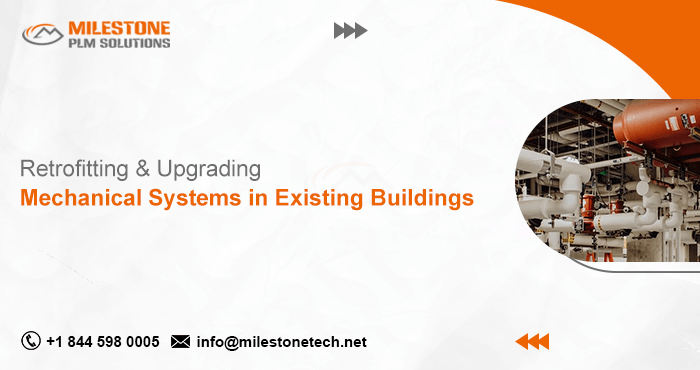Retrofitting and Upgrading Mechanical Systems in Existing Buildings

It is impossible to exaggerate the significance of retrofitting and modernizing mechanical systems in existing structures in the fields of construction and engineering. Modernizing and improving mechanical systems has become essential to building management and engineering services as the focus on energy efficiency, sustainability, and cost-effectiveness grows. This blog explores the importance, difficulties, and techniques related to retrofitting and modernizing mechanical systems in an effort to offer a thorough grasp of this important topics.
The Importance of Retrofitting Mechanical Systems
Any building’s utility comes mostly from mechanical systems including heating, ventilation, air conditioning (HVAC), plumbing, and electrical systems. Older buildings often feature antiquated, ineffective, and prone to failure systems. Several important advantages come from retrofitting and updating mechanical systems in current constructions:
- Energy Efficiency: Older mechanical systems typically consume more energy due to outdated technology and wear and tear. Upgrading these systems can significantly reduce energy consumption, leading to lower utility bills and a reduced carbon footprint.
- Improved Performance: Modern mechanical systems are designed for optimal performance. Retrofitting ensures that buildings can operate more efficiently, providing better indoor air quality, temperature control, and overall comfort.
- Cost Savings: Although the initial investment in retrofitting can be substantial, the long-term savings in energy costs, reduced maintenance, and extended lifespan of the building systems can outweigh the upfront expenses.
- Compliance and Standards: Upgrading mechanical systems ensures compliance with current building codes and standards, which may have become more stringent over time. This is particularly important for ensuring safety and avoiding potential legal issues.
Challenges in Retrofitting Mechanical Systems
While the benefits are clear, retrofitting and upgrading mechanical systems in existing buildings come with a set of challenges:
- Structural Limitations: Older buildings may not have been designed to accommodate modern mechanical systems. Structural limitations can complicate the installation process, requiring creative solutions and potentially additional structural work.
- Disruption to Occupants: Retrofitting projects can be disruptive to building occupants, particularly in residential or commercial buildings that remain in use during the upgrade. Minimizing disruption requires careful planning and scheduling.
- Cost and Budget Constraints: The cost of retrofitting can be high, and securing the necessary budget can be challenging. It is essential to conduct a thorough cost-benefit analysis and explore financing options to ensure the project’s feasibility.
- Compatibility Issues: Integrating new mechanical systems with existing infrastructure can present compatibility issues. Ensuring seamless integration requires careful assessment and planning.
Methodologies for Retrofitting Mechanical Systems
Successfully retrofitting and upgrading mechanical systems involves several key steps and methodologies:
- Assessment and Planning: The first step is a comprehensive assessment of the existing mechanical systems. This involves evaluating their current condition, identifying inefficiencies, and determining the scope of the upgrade. A detailed plan should outline the project’s objectives, budget, timeline, and potential challenges.
- Design and Engineering: Once the assessment is complete, the design phase begins. This involves creating detailed engineering plans that address the specific needs of the building and ensure compliance with modern standards and codes. Collaboration between architects, engineers, and contractors is crucial during this phase.
- Selecting the Right Systems: Choosing the appropriate mechanical systems for retrofitting is vital. Factors to consider include energy efficiency, compatibility with existing infrastructure, ease of maintenance, and overall cost. Modern systems such as high-efficiency HVAC units, smart thermostats, and energy-efficient lighting should be prioritized.
- Installation and Commissioning: The installation phase should be carefully managed to minimize disruption. This may involve phased implementation, working during off-peak hours, or temporarily relocating occupants. Once installed, the systems should be thoroughly tested and commissioned to ensure they operate as intended.
- Monitoring and Maintenance: Post-installation, it is essential to establish a monitoring and maintenance plan. Regular inspections, maintenance, and performance monitoring will ensure the systems continue to operate efficiently and identify any potential issues early.
Conclusion
Retrofitting and upgrading mechanical systems in existing buildings are essential for enhancing energy efficiency, improving performance, and ensuring compliance with modern standards. While challenges exist, careful planning, assessment, and execution can lead to substantial long-term benefits. By prioritizing energy-efficient and sustainable solutions, building owners and managers can create more comfortable, cost-effective, and environmentally friendly buildings. As the demand for sustainable and efficient building practices continues to grow, the importance of retrofitting mechanical systems will only increase, making it a critical focus for the future of construction and engineering.
Follow Milestone PLM Solutions for AEC Industry Updates, CAD Tips and Global Construction News.
Milestone PLM Solutions with its exclusive delivery center in India is a global CAD, BIM outsourcing partner serving the needs of the AEC industry since 2004. MILESTONE focuses on the unique needs of clients and believe in tackling real-life problems with efficiency, smooth and ease.
The MILESTONE team can assist you with DD Set, CD Set, BIM Modeling, Rendering, walk through and more. We support multiple BIM software including AUTOCAD REVIT, Architecture cad, Cabinet Vison, Vector works etc. Our approach is to provide a dedicated team for each customer over ongoing project and deliver the quality output consistently.
With our state of art technology and large talent pool of Engineers & Architects, we are developing best in class solutions for our customers across the globe. We align with your culture and values to form unbreakable partnerships and are primed for success with over 100 employees and 150 customers in the US, Europe, India, and Asia.
You can email us at info@milestonetech.net and can log in to our website www. milestonetech.net to know more about our services and our work portfolio or contact us on +1-844-598-0005
